Loch Ness monster mystery solved? Study claims ancient dinosaur discovery influenced delusion
A new study suggests that the legend of the Loch Ness monster and other long-necked sea monsters may have been influenced by early 19th century dinosaur fossil discovery.
Reports that a creature was living in Scotland's Loch Ness go back to the sixth century. The 19th and 20th centuries, in particular, saw an increase in interest, especially after the infamous "surgeon's photograph" in 1934.
Now, a new study suggests that the legend of the Loch Ness monster and other long-necked "sea monsters" may have been influenced by something very real and even more terrifying — dinosaurs.
Published in the scientific journal Earth Sciences History, the study theorizes that the sea serpent reports of the early 19th century were heavily influenced by early dinosaur fossil discovery.
LOCH NESS MONSTER FOUND? SHOCKING PICTURES OF UNIDENTIFIED SEA CREATURE SURFACE
"Over the last 200 years, there is indeed evidence of a decline in serpentiform sea serpent reports and an increase in the proportion of reports with necks but there is no evidence for an increase in the proportion of mosasaur-like reports," the study's abstract reads. "However, witnesses only began to unequivocally compare sea serpents to prehistoric reptiles in the late nineteenth century, some fifty years after the suggestion was first made by naturalists."

This is an undated file photo of a shadowy shape that some people say is a photo of the Loch Ness monster in Scotland, known as the "surgeon's photograph." (AP Photo, File)
British fossil hunter William Buckland was the first to discover dinosaur fossils in 1819.
Researcher Charles Paxton of the University of St Andrews and paleontologist Darren Naish of the University of Southampton looked at several hypotheses and more than 1,500 alleged cases of "monster" sightings (excluding hoaxes) going back to 1801. From 1801 to the early 1930s, around the time of the "surgeon's photograph," reported sightings of long-necked creatures, such as plesiosaurs (or reports that mentioned plesiosaurs) increased from 10 percent of all sightings to approximately 50 percent.
Paxton and Naish added that the presence of mosasaur-like sightings did not change, likely due to dinosaur fossils starting to be displayed for the first time in museums.
Science fiction writer L. Sprague De Camp was the first to suggest this hypothesis in 1968, writing: "After Mesozoic reptiles became well-known, reports of sea serpents, which until then had tended towards the serpentine, began to describe the monster as more and more resembling a Mesozoic marine reptile like a plesiosaur or a mosasaur."
"The discovery of long-necked marine reptile fossils in the 19th century does appear to have had an influence on what people believe they have spotted in the water," Paxton said in an interview with The Telegraph.
The legend of the Loch Ness monster has commonly been attributed to a plesiosaur that somehow managed to survive the mass extinction event that killed off the dinosaurs.
Supposedly taken by Robert Kenneth Wilson, a London gynecologist, the "surgeon's photograph" was first published in 1934 and appears to show the neck and head of the creature. It was eventually proven to be a hoax years later.
LOCH NESS MONSTER: THIS IS SCOTLAND'S PLAN IF THE FABLES BEAST IS CAUGHT
In May 2018, researchers said they would investigate the waters of Loch Ness in Scotland and use environmental DNA sampling of the waters to try and identify everything that swims in it.
Fox News' Ryan Gaydos contributed to this report.





















